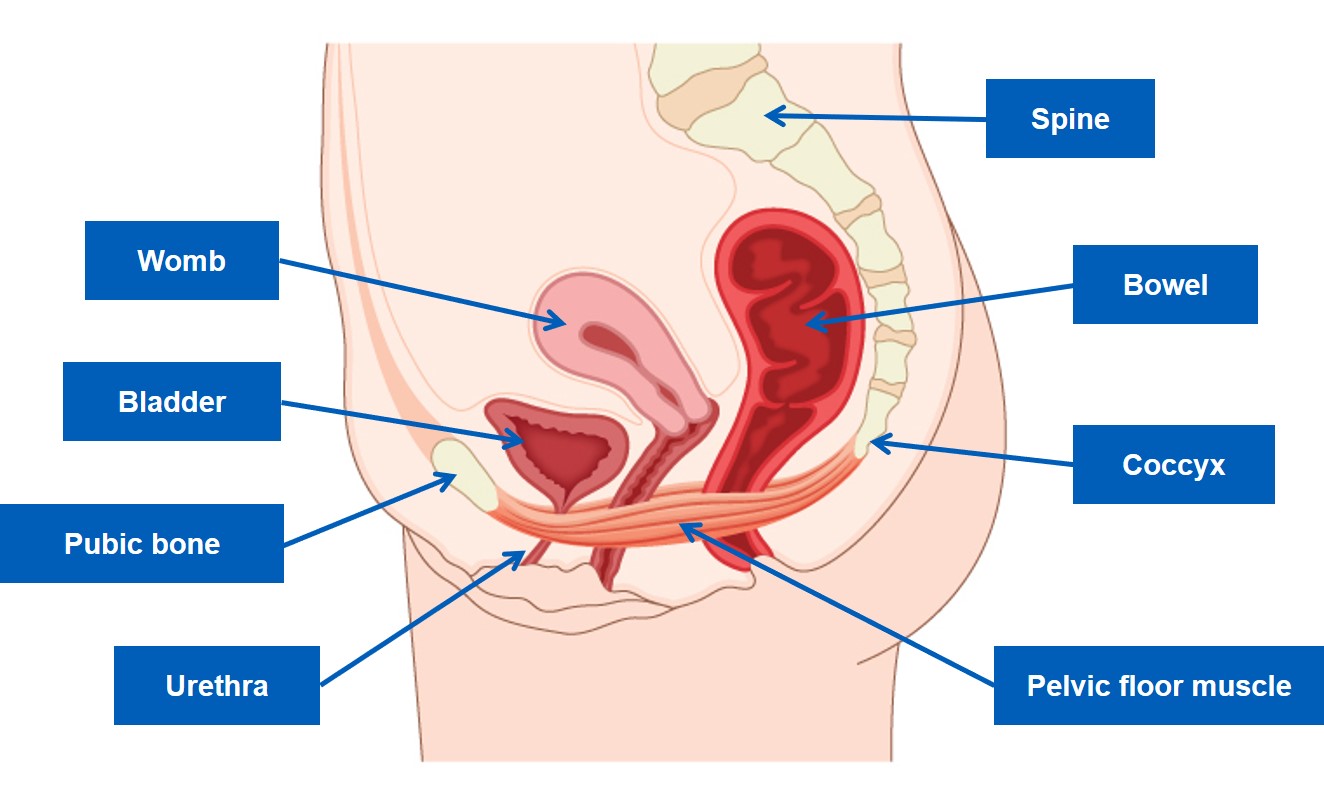Caring for the pelvic floor muscle for people with female anatomy
Last edited: 10/12/2024
Alternative formats
This leaflet is available in:
What is the pelvic floor and why does it become weak?
Strong healthy pelvic floor muscles provide support for the pelvic contents, help to control bladder and bowel function and may improve your sex life.
Many people experience unwanted leakage of urine. Some also have difficulty controlling wind and/or emptying their bowel. The pelvic floor muscles have an important function in preventing these problems.
With female anatomy there are usually three openings: The urethra (the bladder outlet), the vagina (birth canal) and the anus (back passage). The pelvic floor muscles are your undercarriage muscles; they are attached to the base of your spine (coccyx) at the back and your pubic bone at the front. These muscles assist in the control of urine (wee), bowels (poo), and wind. When the bladder, bowel and womb are not supported by the pelvic floor they may start to descend, this is called a prolapse.

Why do the pelvic floor muscles get weak?
The pelvic floor can be weakened by:
- pregnancy – hormones are released during pregnancy which relax the pelvic floor muscles. The delivery can also strain the muscles, particularly with babies over 8lbs, assisted deliveries and long labours
- menopause – alteration of hormone levels
- constipation and/or repeated straining
- repeated and/or heavy lifting
- a chronic cough and/or persistent sneezing
- being overweight
- abdominal, gynaecological or bowel surgery
- a lack of general fitness and/or inactivity
- neurological damage – spinal injury, stroke, multiple sclerosis and/or diabetes.
How do I strengthen the pelvic floor muscles?
The first step is to identify the muscles that need to be exercised. The following needs to be practiced on a regular basis:
- Tighten or pucker the muscle around the back passage as if you are trying to stop wind (or diarrhoea).
- Relax the muscle.
- Imagine that you are lifting a pearl up inside your vagina.
- Relax the muscle.
- Stop an imaginary wee.
- Relax the muscle.
- Imagine there is a zip at your back passage. Imagine pulling that zip forwards from bum to tum.
- Relax the muscle.
Check that you are not squeezing your buttocks, thighs or holding your breath.
Once you feel confident in locating the correct muscles, try to do the following exercises:
- Tighten your pelvic floor. Lift and hold this position for a slow count of up to ten. Release and relax. You will know you are getting stronger when you can do 10 in a row. Each contraction needs to be strong, slow and controlled.
- Repeat this whole exercise routine at least three to four times every day. To get maximum benefit, try performing your exercises in a variety of positions, such as lying, sitting, standing and walking.
- If you leak when coughing, sneezing, running, laughing, lifting etc. practice tightening your muscles before an activity that causes the leakage.
An easy way to remember your exercises is to associate them with an activity that you perform every day. For example, whilst brushing your teeth, after going to the toilet, making a drink, watching television, walking, gardening, vacuuming and bending etc. To work the muscles quickly and help them to react to sudden stresses, draw in the pelvic floor and hold this position for just one second before letting go. Repeat this quick strong contraction up to 10 times.
Be patient! Any exercise programme takes time to work. Everyone is different.
Your physiotherapist or bladder and bowel nurse specialist can help with further advice if frequent trips to the toilet and accidents are a problem.
Are there any other things that help?
- Remember to tighten your pelvic floor before lifting anything.
- Avoid constipation by eating five portions of fruit and vegetables daily.
- Do not restrict your fluids. Aim to drink around two litres a day.
- Don’t get into the habit of going to the toilet just in case. Only go when your bladder is full. Ideally you should be able to last two to three hours between wees. If you need to go more than every
- two hours you can retrain your bladder to wait for longer by either tightening your pelvic floor or distracting yourself from needing to go to the toilet.
- Avoid caffeinated tea, coffee and diet drinks as they may irritate your bladder and bowel. Reduce caffeine intake gradually to avoid headaches.
- Keep your weight within the right range for your height and age.
- Seek medical advice for hayfever, asthma or bronchitis to reduce sneezing and coughing.
- Avoid straining during a bowel movement. Check your position on the toilet. Try leaning forward and raising your heels and resting your forearms on your thighs – as if you were reading a book.
This information should only be followed on the advice of a healthcare professional.
Do you have feedback about our health services?
0800 030 4550
Text 07899 903499
Monday to Friday, 8.30am to 4.30pm
kentchft.PALS@nhs.net
kentcht.nhs.uk/PALS
Patient Advice and Liaison Service (PALS)
Kent Community Health NHS Foundation Trust
Trinity House, 110-120 Upper Pemberton
Ashford
Kent
TN25 4AZ
![]()
Donate today, and help the NHS go above and beyond. Visit kentcht.nhs.uk/icare
If you need communication support or this information in another format, please ask a member of staff or contact us using the details above.
